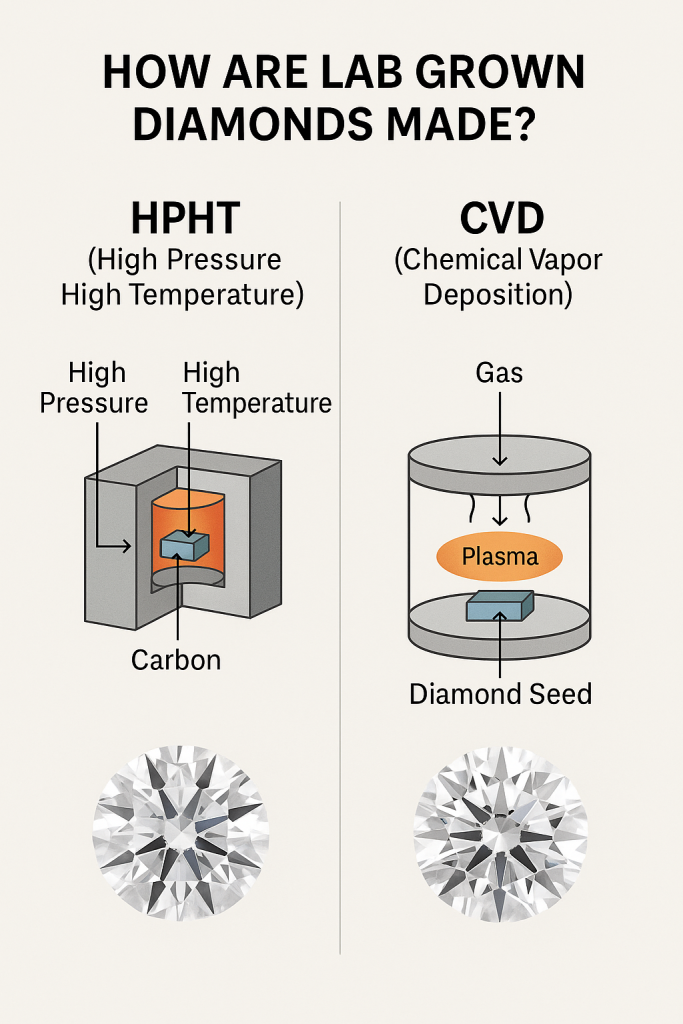How Lab-Grown Diamonds Are Made: The Science Behind the Sparkle
Lab-grown diamonds have revolutionized the jewellery industry, offering consumers a sustainable, ethical, and cost-effective alternative to mined diamonds. These diamonds are chemically and physically identical to natural diamonds but are produced in controlled laboratory environments using advanced technological methods.

1. High Pressure High Temperature (HPHT) Method
The HPHT method is one of the earliest techniques developed to create lab-grown diamonds. In this process, a small diamond seed is placed into pure carbon and subjected to extreme pressure and temperature conditions. The setup mimics the natural environment of the Earth’s mantle, where diamonds are formed over millions of years.
Process Overview:
-
Pressure and Temperature: The chamber is pressurized to about 5 GPa (gigapascals) and heated to approximately 1500°C.
-
Carbon Source: The carbon source, often graphite, melts and crystallizes around the diamond seed, forming a diamond.
-
Growth Time: The process can take several weeks to produce a rough diamond.
2. Chemical Vapor Deposition (CVD) Method
The CVD method involves a different approach to diamond synthesis. In this process, a diamond seed is placed in a vacuum chamber filled with carbon-rich gases, such as methane and hydrogen. The gases are heated to high temperatures, causing them to ionize and deposit carbon atoms onto the seed, gradually forming a diamond.
Process Overview:
-
Gas Introduction: Carbon-rich gases are introduced into the chamber.
-
Plasma Formation: The gases are heated to create a plasma, breaking down the gases into carbon atoms.
-
Diamond Growth: Carbon atoms deposit onto the diamond seed, forming a diamond layer by layer.
-
Growth Time: This process typically takes a few weeks to produce a rough diamond.
Differences Between HPHT and CVD Diamonds
While both methods produce diamonds with the same physical and chemical properties as natural diamonds, they differ in their formation processes and resulting characteristics.
| Feature | HPHT Diamonds | CVD Diamonds |
|---|---|---|
| Growth Shape | Cuboctahedral (14 growth directions) | Cubic (1 growth direction) |
| Color | Often yellow or brown; can be treated to improve color | Typically colorless or near-colorless |
| Clarity | May contain metallic inclusions | Higher clarity; fewer inclusions |
| Cost | Generally more expensive | More cost-effective |
| Production Time | Longer (weeks to months) | Shorter (weeks) |
Benefits of Lab-Grown Diamonds
-
Ethical Sourcing: Lab-grown diamonds are produced without the ethical concerns associated with mined diamonds, such as human rights abuses and conflict financing.
-
Environmental Impact: The production of lab-grown diamonds typically has a lower environmental footprint compared to traditional mining, reducing land disruption and water usage.
-
Cost-Effectiveness: Lab-grown diamonds are often more affordable than mined diamonds, offering consumers high-quality options at a lower price point.
-
Customization: The controlled environment allows for precise customization of diamond size, shape, and quality.
Conclusion
Lab-grown diamonds, produced through HPHT and CVD methods, offer a sustainable and ethical alternative to mined diamonds. Both methods produce diamonds with identical physical and chemical properties to natural diamonds, providing consumers with high-quality options that align with modern values of sustainability and ethics. As technology advances, the availability and affordability of lab-grown diamonds continue to improve, making them an increasingly popular choice for conscious consumers.
In case you want to know more about Lab Grown Diamonds reach out to us Here.
Instagram | Facebook | LinkedIn | Pinterest | WhatsApp
